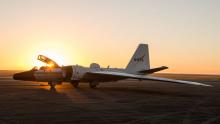Listen to today's episode of StarDate on the web the same day it airs in high-quality streaming audio without any extra ads or announcements. Choose a $8 one-month pass, or listen every day for a year for just $30.
You are here
Orion Sieve
The Orion Nebula is one of the most remarkable regions in our part of the galaxy. It’s a giant complex of clouds of gas and dust that are forming new stars. So far, it’s given birth to thousands of them, of all sizes. And many more are taking shape even now. But some of those stars are starting to shut down the process.
Astronomers looked at the nebula with SOFIA, an airborne observatory that was retired in September. In particular, they looked at what was happening at the rim of a giant bubble. It surrounds the Trapezium, a small group of especially hot, bright, massive stars.
Radiation and strong “winds” from those stars created the bubble in the first place, blowing away the surrounding gas and dust. The SOFIA observations showed that today, the Trapezium is producing big outflows of hot gas — like interstellar rivers. The outflows are drilling thousands of tiny holes in the bubble — making the rim as porous as a sieve.
As gas flows out of those holes, it rams into material outside the bubble. That blows away some of the gas and dust that might otherwise make more stars — helping shut down starbirth in the Orion Nebula.
The nebula is well up in the south as night falls, below Orion’s three-star belt. Under mildly dark skies, it’s visible to the unaided eye as a hazy smudge of light. It’s easier to see if you look at it out of the corner of your eye — the combined fires of thousands of young stars.
Script by Damond Benningfield





